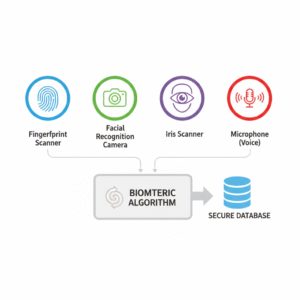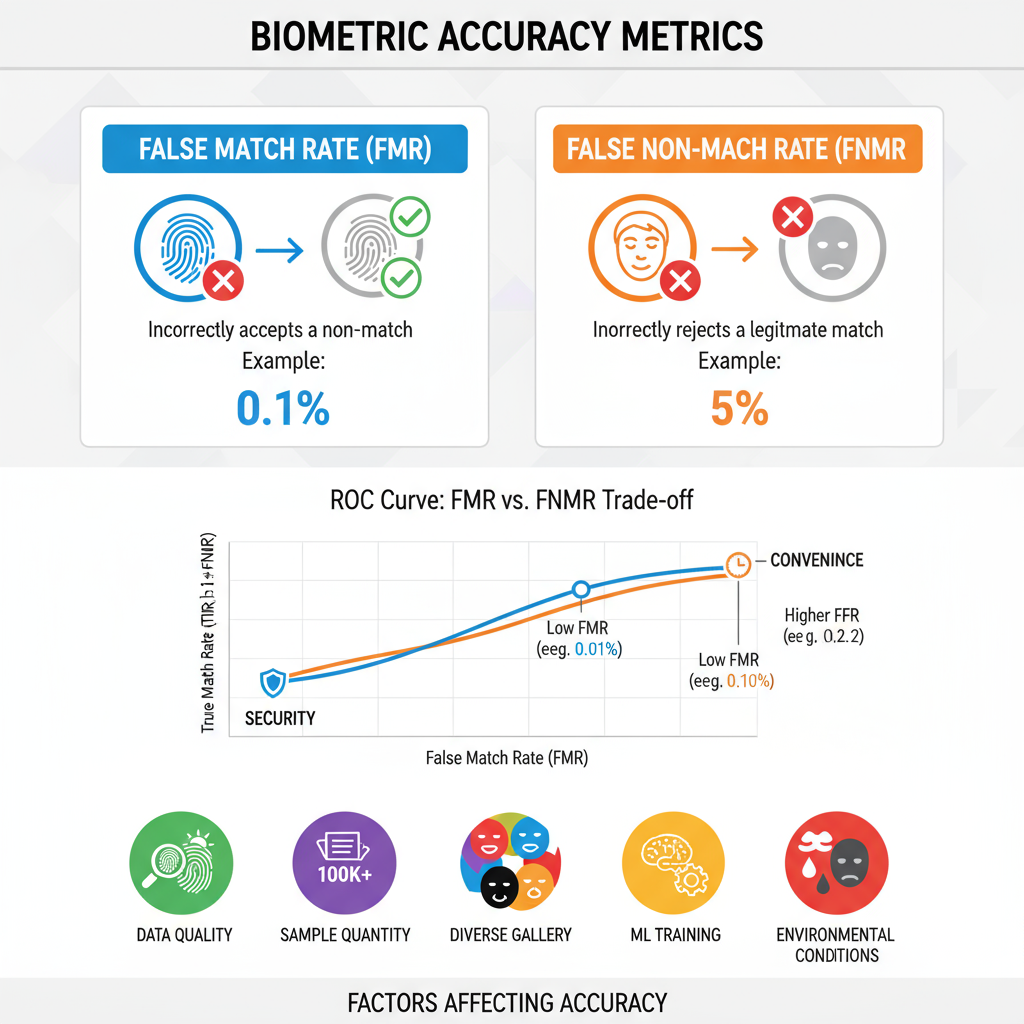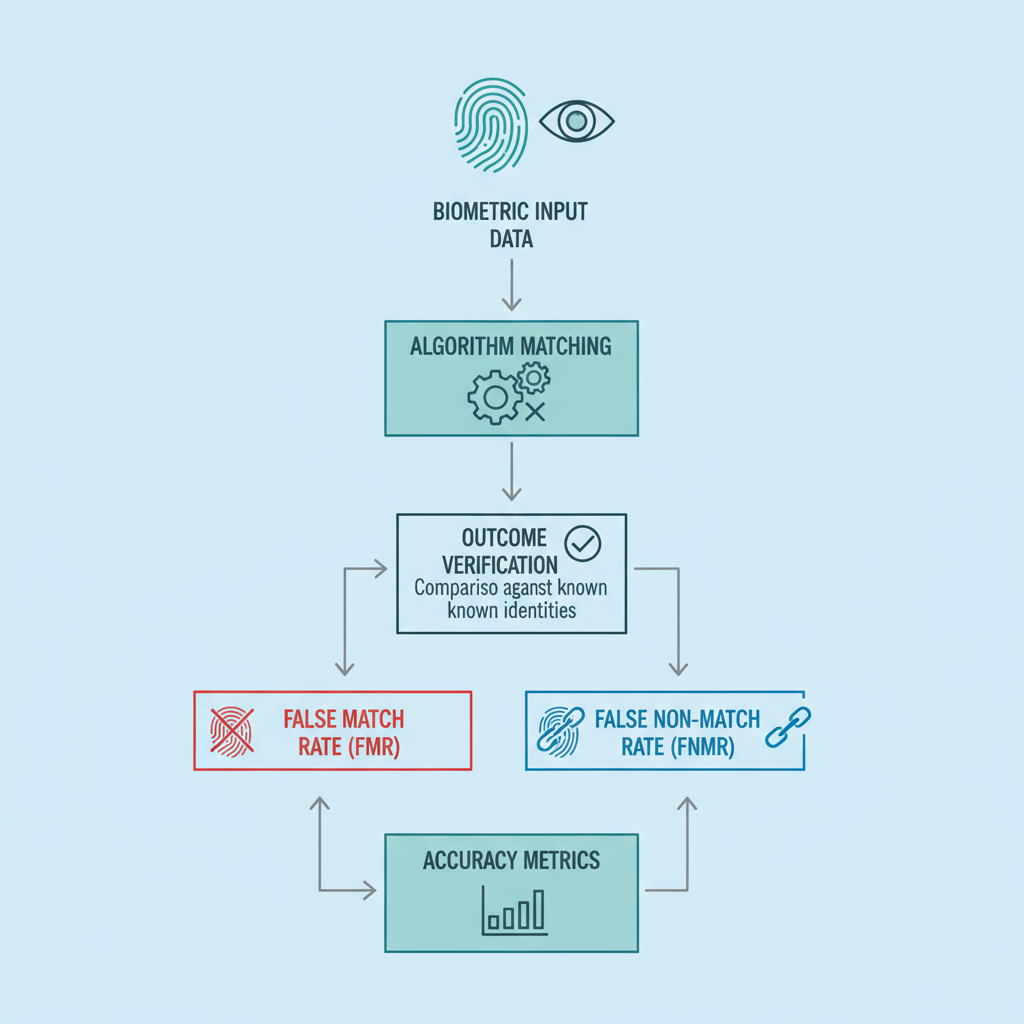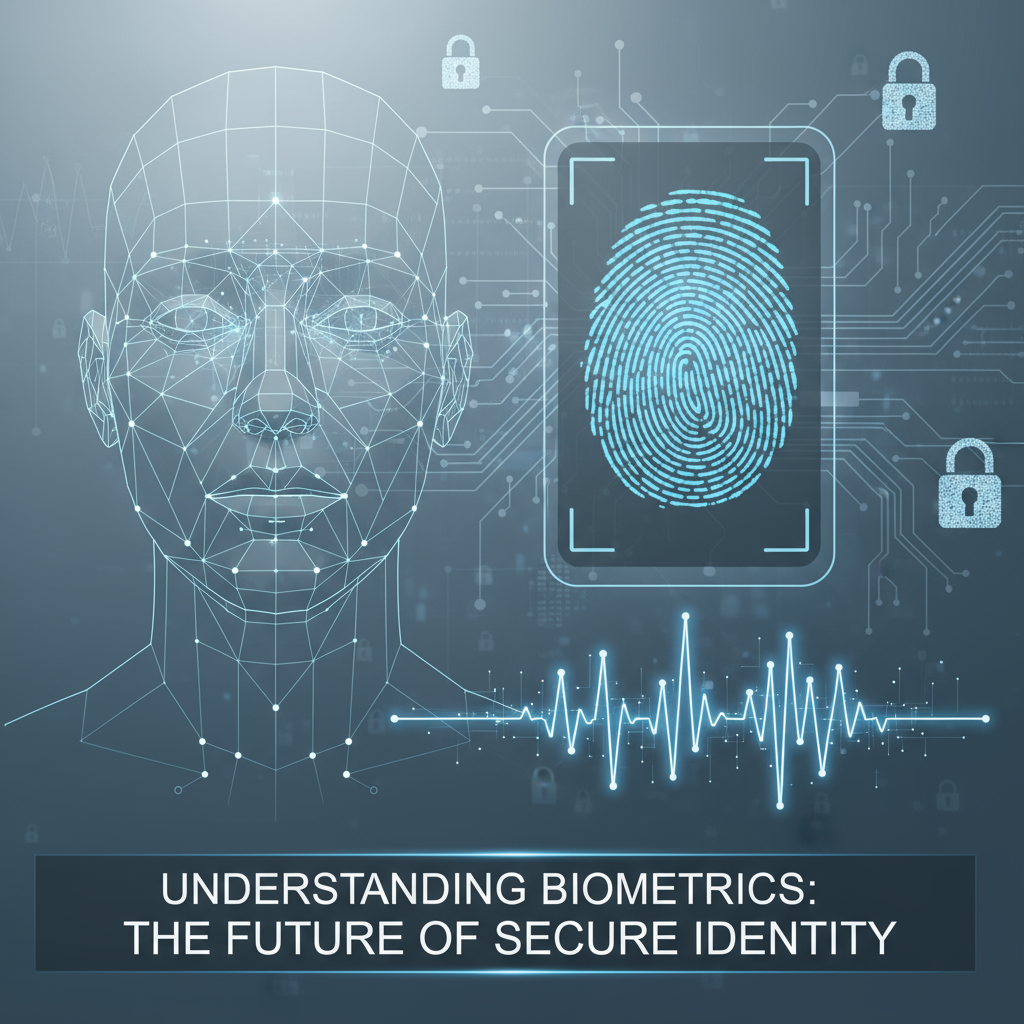Summary
In today’s increasingly digital world, identity verification has become more critical than ever. Biometric systems, which rely on unique physical or behavioral characteristics such as fingerprints, facial features, voice patterns, or iris scans, have revolutionized authentication. However, the effectiveness of these systems depends heavily on their accuracy. Biometric system accuracy testing is the process of evaluating how reliably these systems can identify or verify individuals, ensuring both security and user convenience.
This blog explores the principles of biometric systems, key metrics like false match rate (FMR) and false non-match rate (FNMR), factors affecting accuracy, real-world challenges, and best practices for testing and deploying biometric systems.
Why Biometric Accuracy Matters
Biometrics have become the cornerstone of modern identity verification. Unlike traditional methods such as passwords or PINs, biometric identifiers are inherently tied to an individual, making them difficult to steal, forge, or replicate. This is particularly important in sensitive applications like:
- Banking and financial services: Verifying customers during onboarding, preventing account takeover, and securing high-value transactions.
- Healthcare: Ensuring the right patient receives the correct treatment while maintaining privacy.
- Government and law enforcement: Enabling secure access to services, border control, and criminal identification.
- Consumer technology: Unlocking devices and enabling secure app authentication.
However, even the most sophisticated biometric systems are not perfect. Accuracy directly impacts both security and user experience. A system that frequently fails to recognize legitimate users can frustrate them and reduce adoption. Conversely, a system that incorrectly matches impostors can lead to security breaches. This is where biometric system accuracy testing becomes critical—it quantifies how well a system performs and helps organizations make informed deployment decisions.
Also Rad: How To Enhance User Trust And Adoption Of New Technologies
What is Biometric Systems

Before diving into accuracy testing, it’s essential to understand how biometric systems function. At their core, biometric systems consist of sensors, algorithms, and databases.
- Sensors: Capture physical or behavioral traits. Examples include fingerprint scanners, high-resolution cameras for facial recognition, microphones for voice recognition, and iris scanners.
- Algorithms: Convert raw biometric data into templates and compare them against stored data to determine a match.
- Databases: Store biometric templates for verification or identification purposes.
Modes of Operation
Biometric systems operate in two main modes:
Verification (One-to-One Matching):
The system confirms whether the captured biometric sample matches the claimed identity stored in the database. For example, when a user unlocks their smartphone with a fingerprint, the device checks if the scanned fingerprint matches the stored template. Verification emphasizes user convenience and speed while maintaining security.
Identification (One-to-Many Matching):
The system searches a database of biometric templates to determine the individual’s identity. This mode is commonly used in law enforcement or large-scale employee management, where the system must search across thousands or millions of records to find a match. Identification is computationally intensive and requires high accuracy to avoid false matches.
Types of Biometric Identifiers

Different biometric modalities have varying levels of accuracy, convenience, and security:
Fingerprint Recognition:
The most widely used biometric due to its low cost and high accuracy. Fingerprints have unique ridge patterns, and modern algorithms can extract minutiae points to create robust templates. Fingerprint recognition is commonly used in smartphones, access control, and attendance systems.
Facial Recognition:
Analyzes facial geometry and features to verify identity. Facial recognition algorithms are trained on vast datasets and benchmarked for accuracy. Its non-intrusive nature makes it ideal for surveillance, secure access, and customer identification.
Iris and Retina Scans:
Eye-based biometrics capture detailed structures like iris patterns or retina blood vessels. These traits remain stable over a lifetime, offering extremely high accuracy for secure environments, such as airports or government facilities.
Voice Recognition:
Analyzes vocal patterns, pitch, cadence, and speech rhythm. Voice biometrics are ideal for remote authentication, especially in call centers or financial services, as they do not require physical presence.
Each biometric type has trade-offs in terms of accuracy, convenience, cost, and environmental susceptibility. These differences make accuracy testing even more essential to ensure the system meets the intended use case.
What is Biometric System Accuracy Testing?
Biometric system accuracy testing is the process of evaluating how reliably a biometric system identifies or verifies individuals using their unique physical or behavioral traits.
Objectives of Accuracy Testing
The primary objectives are:
- Measure system reliability: Determine how often the system correctly recognizes legitimate users and rejects impostors.
- Enhance security: Reduce false matches to prevent unauthorized access.
- Improve user experience: Minimize false non-matches to prevent frustration for legitimate users.
- Compliance assurance: Ensure the system meets regulatory standards for data protection, identity verification, and security.
Accuracy testing is not a one-time activity—it must be an ongoing process to account for changing environmental conditions, demographic variations, and algorithm updates.
Key Metrics in Biometric Accuracy Testing

Biometric system accuracy is typically quantified using False Match Rate (FMR) and False Non-Match Rate (FNMR), often visualized with Receiver Operating Characteristic (ROC) curves.
False Match Rate (FMR)
- FMR represents the probability that the system incorrectly matches samples from different individuals.
- High FMR indicates a security risk, as impostors could be granted access.
- Example: In a fingerprint verification system, if the FMR is 0.1%, it means that 1 in 1,000 attempts from different individuals could be incorrectly accepted.
False Non-Match Rate (FNMR)
- FNMR measures the probability that the system fails to match samples from the same individual.
- High FNMR reduces user convenience and may cause frustration.
- Example: In a facial recognition system with FNMR of 1%, 1 in 100 genuine users may be denied access despite being legitimate.
ROC Curves
- ROC curves graphically represent the trade-off between FMR and FNMR at different matching thresholds.
- Higher thresholds: Reduce FMR (higher security) but increase FNMR (lower convenience).
- Lower thresholds: Reduce FNMR (higher convenience) but increase FMR (lower security).
- By analyzing ROC curves, organizations can select an optimal threshold that balances security and user experience for a given application.
Factors Affecting Biometric Accuracy
Several factors influence the accuracy of biometric systems, making thorough testing essential:
1. Quality of Biometric Data
High-quality samples lead to more accurate matches. For example:
- Fingerprint scans must be clear, with minimal smudges or distortion.
- Facial recognition requires proper lighting, neutral expressions, and frontal faces.
- Voice recognition works best with minimal background noise and consistent speech.
Poor data quality can significantly increase both FMR and FNMR, undermining system reliability.
2. Quantity of Samples
The number of samples captured per individual impacts accuracy, particularly in one-to-many searches. Systems with multiple biometric templates per user are more resilient to variations and environmental changes.
3. Biometric Gallery Composition
The nature of the dataset (biometric gallery) used for testing affects results:
- Systems trained on limited or homogeneous datasets may overfit, performing well on known samples but poorly on unseen users.
- Diverse datasets that reflect real-world demographics provide more realistic accuracy measurements.
4. Algorithm Training
- Machine learning algorithms used for biometric matching can be “trained” to recognize specific patterns.
- While training improves performance on known data, it may not guarantee real-world accuracy.
- Testing on unseen or external datasets is critical to simulate real deployment scenarios.
5. Environmental and Technical Conditions
- Lighting, background noise, sensor resolution, and device positioning affect accuracy.
- For example, a fingerprint scanner may struggle with wet fingers, and facial recognition may fail in low-light environments.
Accuracy Testing in Real-World Scenarios
Accuracy testing is crucial for real-world deployment because biometric systems often interact with diverse populations and environmental conditions.
Use Cases
- Banking and Financial Services:
Biometric verification enhances KYC compliance, reduces account takeover, and secures transactions. Systems must maintain high accuracy across thousands or millions of customers. - Government and Border Security:
Airports and immigration authorities use biometric identification to prevent identity fraud and streamline passenger processing. Accuracy ensures that legitimate travelers are recognized while impostors are denied access. - Healthcare:
Hospitals leverage biometrics to authenticate patients, staff, and equipment access. Accurate systems prevent medical errors and ensure privacy.
Industry Benchmarks
- Organizations like the National Institute of Standards and Technology (NIST) perform rigorous benchmarking of biometric systems.
- These benchmarks help evaluate the performance of facial recognition, fingerprint scanning, and other modalities under standardized conditions.
Challenges in Biometric Accuracy Testing
Despite advances in biometric technology, testing systems face several challenges:
1. Privacy and Data Protection
- Biometric data is considered highly sensitive.
- Improper storage or misuse can lead to identity theft, legal violations, and loss of trust.
- Organizations must implement encryption, secure storage, and strict access controls.
2. Bias and Fairness
- Some biometric systems perform differently across demographic groups, such as gender, ethnicity, or age.
- Regular testing is required to identify and mitigate bias, ensuring equitable access and security.
3. Changing Conditions
- Physical changes in individuals (aging, injuries) and environmental variations (lighting, noise) can affect accuracy.
- Continuous monitoring and retraining of algorithms are necessary to maintain performance.
Best Practices for Biometric System Accuracy Testing
To maximize performance and compliance, organizations should follow these best practices:
Continuous Evaluation:
Test biometric systems regularly using diverse, real-world datasets.
Multi-Factor Authentication (MFA):
Combine biometrics with other authentication factors, such as OTPs, passwords, or smartcards, for enhanced security.
Secure Biometric Data:
Store templates in encrypted form and separate from other personal data.
Audit for Bias and Accuracy:
Conduct periodic audits to detect demographic biases and ensure fairness.
Update Algorithms Regularly:
Refresh models to adapt to environmental changes, new data, and emerging threats.
Threshold Optimization:
Adjust matching thresholds based on the trade-off between FMR and FNMR to achieve the desired balance between security and convenience.
Conclusion
Biometric system accuracy testing is a vital process for ensuring that biometric systems deliver reliable, secure, and user-friendly identity verification. By understanding metrics like FMR and FNMR, analyzing ROC curves, and considering factors such as data quality, environmental conditions, and demographic diversity, organizations can optimize performance for real-world deployment.
A well-tested system reduces fraud, improves compliance with regulations, and enhances trust between users and organizations. As biometric technologies evolve, continuous accuracy testing, algorithm updates, and privacy-conscious practices will remain key to maximizing the potential of biometrics while safeguarding user identities.
FAQ
What is biometric system accuracy testing?
It is the process of evaluating how reliably a biometric system identifies or verifies individuals using physical or behavioral traits.
Why is ROC curve important in biometric testing?
ROC curves show the trade-off between false match rates and false non-match rates, helping organizations select thresholds that balance security and convenience.
How do false match and false non-match rates affect security?
High FMR increases the risk of unauthorized access, while high FNMR can frustrate legitimate users. Optimizing thresholds helps mitigate both risks.
Can accuracy differ between demographic groups?
Yes. Differences in age, gender, ethnicity, or physical conditions can affect recognition rates, highlighting the importance of unbiased testing.
How often should biometric systems be tested for accuracy?
Testing should be continuous, especially after algorithm updates, environmental changes, or deployment in new locations.
How can organizations ensure privacy while using biometrics?
By encrypting data, storing templates separately, implementing strict access controls, and complying with regulations like GDPR, organizations can maintain security and privacy.
Debabrata Behera is a passionate blogger who writes about digital trends, personal growth, and practical insights, helping readers stay informed, inspired, and ready to achieve success in life.





